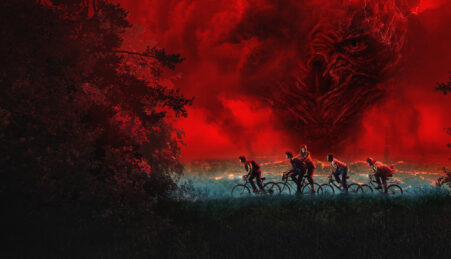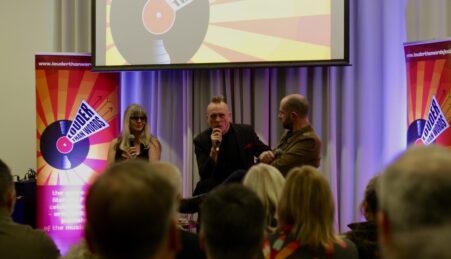By Grace Atkinson
Manchester Metropolitan University’s Research in Arts and Humanities programme (RAH!) hosted an afternoon of lectures, art installations and presentations on ‘Encountering the Dead’ in All Saints Park this month. The events formed part of Encountering Corpses III, a two-day symposium that explored the notion of death and the corpse.
Research Impact and Public Engagement Manager for the Faculty of Arts and Humanities Helen Darby outlined the programme, saying, “We’ve been doing this for four years now. We had an event in 2014 when we went to Manchester Museum and encountered the Egyptian remains there; 2016 when we went to Southern Cemetery and had an event there in the crematorium, and we’ve had our third event, where we’ve encountered the 16,000 plus dead people that still are residing in All Saints Park in the middle of the Manchester Met campus.”
Darby went on to introduce the speakers and give an overview of All Saints Park. She remarked that, for some, the park is just a space to eat sandwiches, saying, “We know there’s profane, culinary and leisurely activities taking place in this park, but we also know, when we read the plinths, […] this was previously a burial ground, and remains a consecrated ground.”
Darby outlined the various memorials that the park inhabits, from ancient stone circles and memorials to the Africans murdered in Manchester in slavery times, to contemporary memorials of former Manchester Met students and staff. “This, then, is a space prosaic and profane, sacred and mystical all at once.”
Darby then turned her attention to those actually buried in the park, saying, “For the encounters in this series, I’ve wanted you, the participants, to feel viscerally that the human remains that we’re encountering are present, I want you to feel their bones in your bones […] we’re asking you to consider the dead below the ground, and send your consciousness under the earth to meet them.”
As a part of the event, Darby created an art installation in the park. This consisted of white, leaf shapes, hung along the branches of a tree. On each leaf was etched a name of one of the 16,000 people buried at the park. Darby explained how she was inspired by acts of informal collection and ceremony, like the locks on railings and docks, or ribbons tied to landmarks. The leaves were shaped by the debris and decay of the park, their whiteness both reverent and ghostly.
Those buried in the park did not die of tragic illnesses or disaster, but are the ‘the unremarkable dead’. Darby’s installation remembers the ‘ordinary’ deaths, while, at the same time, illuminating the impossibility of a permanent or perfect memorial.
Darby explained, “I believe that remembering everyone, including the unremarkable, can connect us back to the veracity of death and the shared fellowship of all human beings. In an attempt to remember everyone, we accept the intrinsic value of all people without agenda.”
She also commented on the tendency we have to disconnect ourselves from the death that is around us; to close the door of an abattoir, or ignore the refugees dying in an attempt for freedom: “There is no stone carved for eternity for any of us, only hauntings that can be brought to mind as shadows of our own passing. It is in these shadows, I believe, rather than in marble and granite, that we can find an inscription that remembers everyone.”
Next, Darby invited Michala Hulme to the stage. Hulme is a genealogist and history lecturer at the Manchester Centre for Public History and Heritage at Manchester Met. “I started off all very light-hearted,” she joked about her recent years working with death. “And now I’m shunned wherever I go, but I found friends,” she added, smiling at the audience.
Hulme gave a thorough overview of the history of All Saints Park and explained how Manchester’s sudden population growth in the early 19th century meant the crude death rate became higher than London’s, at 33 per thousand. All Saints burial ground was constructed to cope with the influx of bodies, the church built in 1802. Hulme went on to describe the well-to-do neighbourhood, the problems faced with body snatchers, and the 1850 church fire.
Hulme also explained how her thesis looks at the 1850 burial act and its effectiveness in providing more sanitary living conditions, as well as the mass-grave, where up to 35 bodies could be piled on top of each other, which the Manchester public complained was an eye-sore, often being left open to await new bodies.
Hulme finished her lecture talking about the park’s reconstruction in 1935 and how, after damage during the Blitz, the church was removed, its bell sent to another All Saints church in Canada.
Ian Drew, Physical Geographer from the School of Science and the Environment, then presented the technique Ground Penetrating Radar (GDR). Though he usually uses it to identify structures and changes in sediment below ground, Drew used the GDR in All Saints Park to scan for buried features such as bodies, gravestones and other objects. Drew showed images taken by the GDR, which mapped a multitude of objects beneath the surface, and measured the depth of their burial.
One thing that the GDR found was that a disproportionate amount of what would appear to be graves were found towards the back of the park, assumingly with the intention of keeping them further from the congestion of Oxford Road.
Artist Debbie Sharp was last to attend the stage, as she introduced her sound art-piece ‘Reawaken with the Dead of Grosvenor Square’. Sharp spoke about her practice, saying, “Over the past few years I’ve been working within the subject of death, remembrance and mortality. As an artist, I can bring the unknown into our realm, where we can temporarily embody this space between life and death.”
Sharp’s previous works include ‘Requiem for the Darkness’, ‘The Truth of the Light’ and ‘Within Memoriam’, installations that she performs for audience members to go and experience; false environments where she uses triggers to evoke memory and emotion.
As the audience were invited to download Sharp’s piece, she said, “I want this journey to take you from being stood on the surface of the park, to absorbing you and pushing you deep into the soil itself.”
Each of us putting in our earphones and stepping out into the snow, the audience began to walk around All Saints Park, while listening to Sharp’s work. The piece began quietly, with what sounded like howling wind, creaking wood and low mumbling. The muffled sounds gave a sense of being underneath the ground. This escalated into heavy, desperate breathing, and the sound of heavy stone being moved above, the traffic on Oxford Road becoming a part of the building chaos.
The piece climaxed into a releasing sigh, and a sense of ease passed over the park. There was a real sense of a cyclical journey, as if joining the dead below on their passing to another realm. As the piece died down, Helen Darby’s memorial artwork swayed in the snow, and the names on each white leaf faded with the light.
For more information about upcoming RAH! events, visit the RAH! website.





Leave a reply